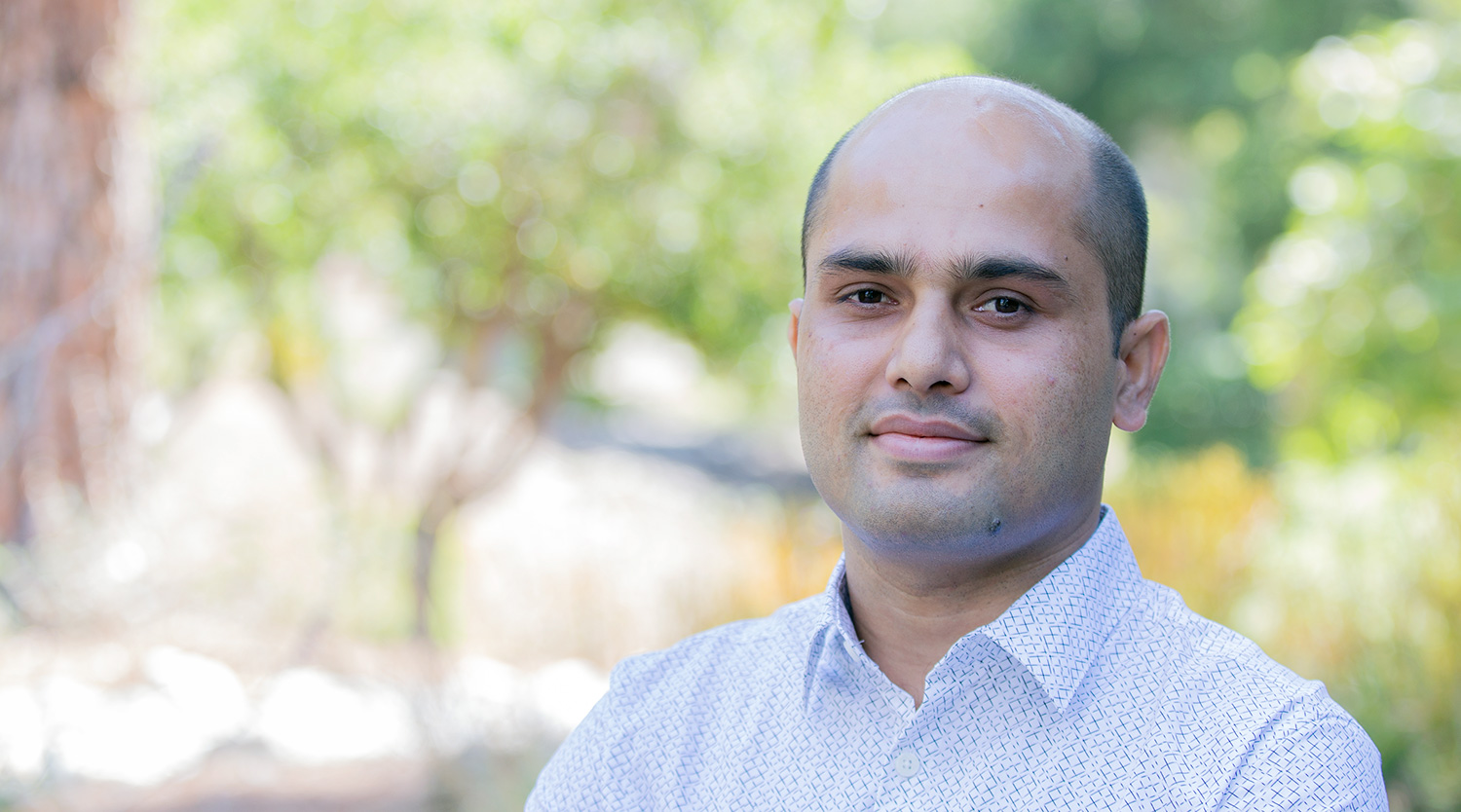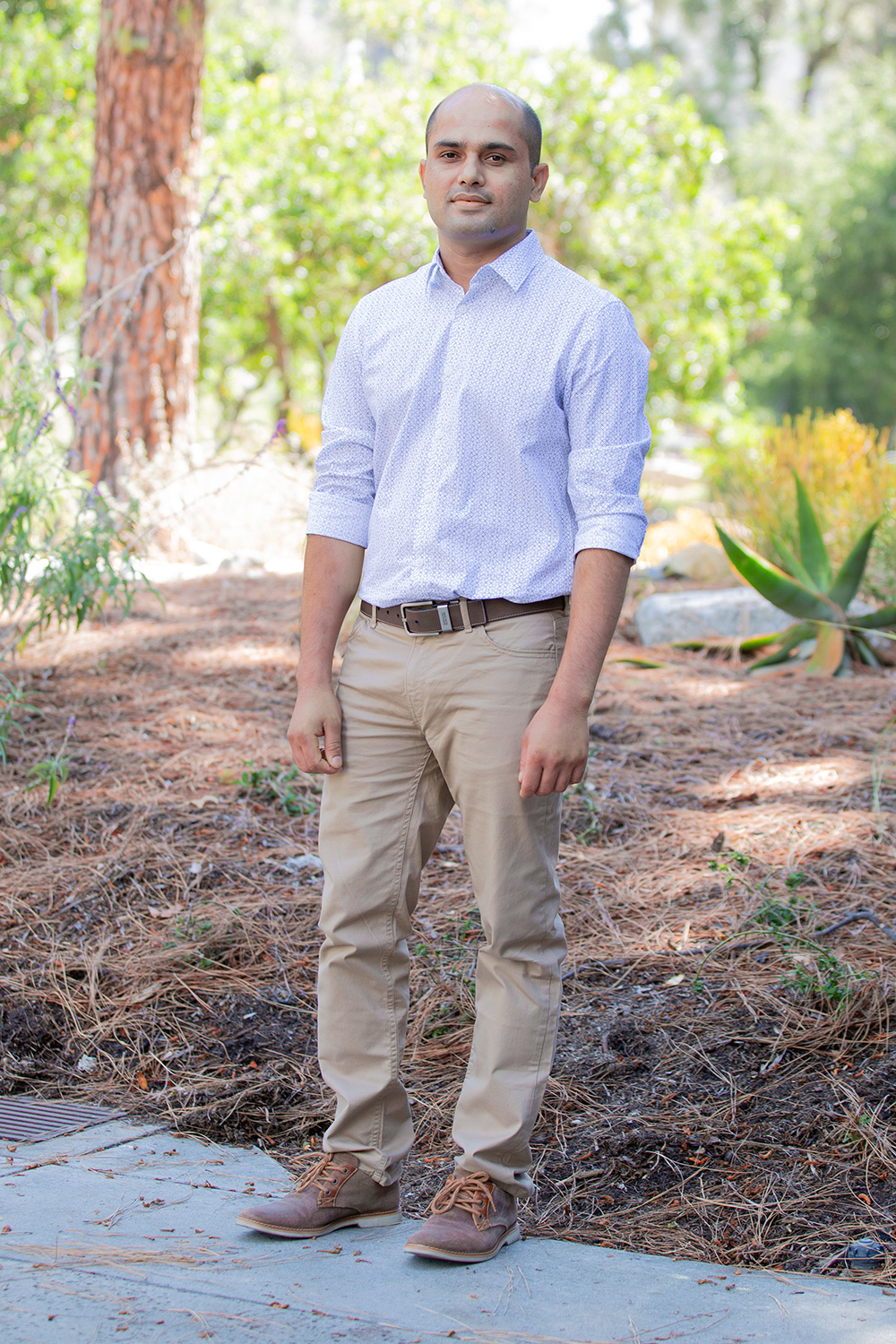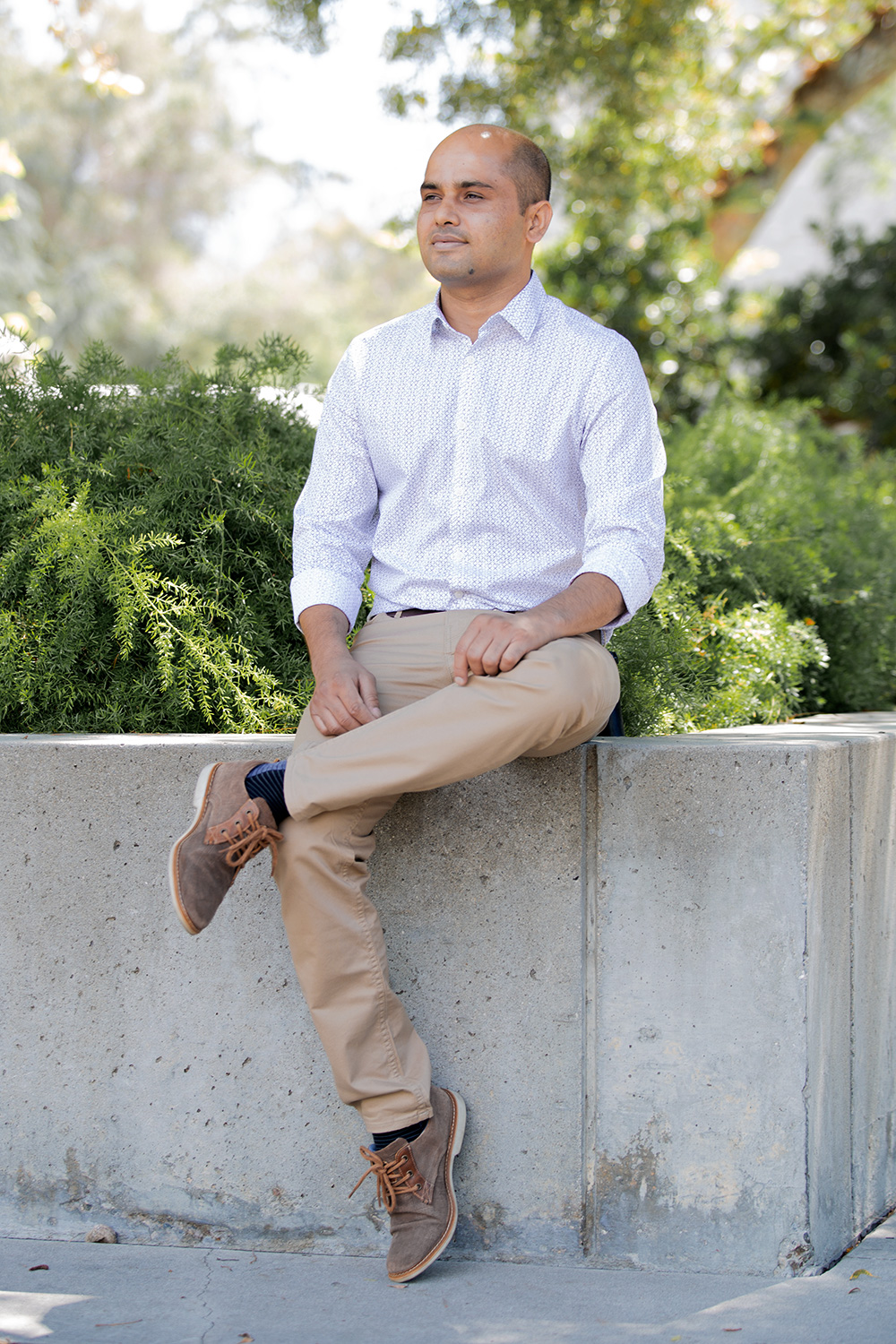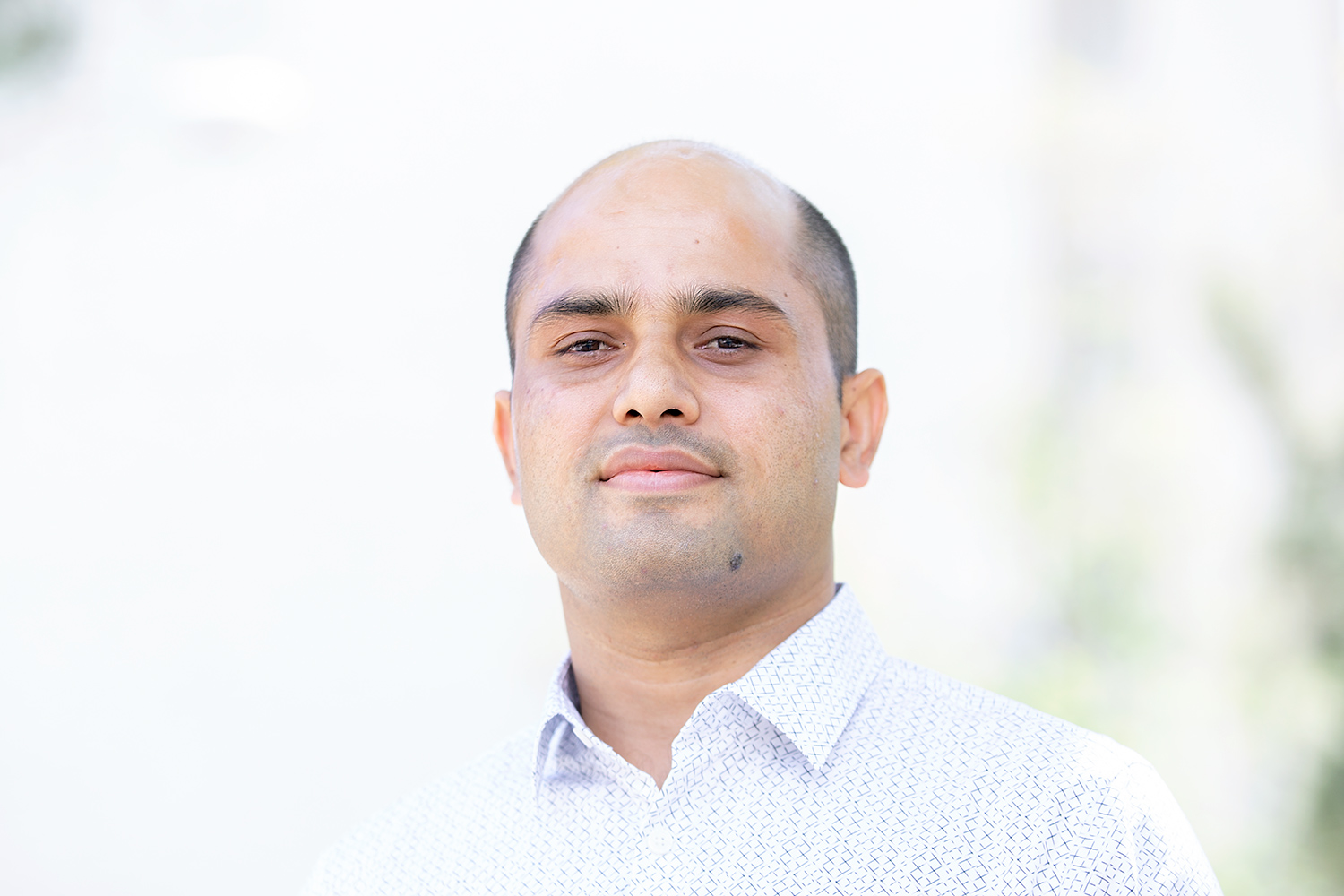- Article № 008
- September 2018
Surendra Adhikari
- Geophysics

Did you spend a lot of time in nature growing up?
Yeah. I mean, in Nepal, it’s nature all the time. I was very fascinated by the Himalayas. These mountains are so tall, right? But, I was not really into hiking when I was a kid. The first time I went… the highest elevation I climbed was 5,500 meters. That happened when I was like 23, 24 years old.
I imagine those mountains had a presence.
Definitely, yeah. I mean… I feel something pristine when I think about snowfall and these high mountains.
In a previous interview, you stated that you had always been attracted to snow.
That is precisely true, yeah. I used to imagine snowfall. In Kathmandu, in the nearby mountains, we get to see snow every winter. But in my village, never. And I was very fascinated by snow. That is for sure. Even now. I don’t think I can articulate it well enough, no matter how hard I try. Like, why do you love flowers? I mean, it’s like this… you look at beautiful flowers, and [they are] amazingly beautiful things, but… I don’t know how to say it more than that, for me at least. But, one thing is... I just love to watch snowflakes falling down. Even tiny flakes. That is something that I truly admire.
The attraction is on a gut level... I understand that. Was that where you were raised? In Nepal, near Kathmandu?
So, I was born and raised in a small village near Kathmandu. I did my high school level studies there. My Dad used to be a high school teacher, so it was natural for us to study there. And then I went to another town to do engineering—I did my undergraduate level study from Nepal. And then I came to the U.S.
Did your father steer you towards science?
In a way... yes. My dad, even now, he's a very strict guy. So, I have a brother, and we used to go to the same school—same class. And my brother was an inspiration when I was young. Basically, at that age, you have to get good grades. And my Dad used to guide my brother. And he used to come first in class, and I used to come second. All the time. Grade 1 through 10.
Your brother would come first and you would come second?
Exactly. Yeah. And in my case, most of the focus would be for him because he was the first kid of my parents. And, because they thought he would be more responsible in terms of listening to what my parents would say. So, I was simply being there, next to my brother, and learning from him.
In Nepal, even now, if your kids are good—especially in math or physics—then the parents would say you have to become an engineer. And if your kids are good at chemistry or biology, then you have to become a medical-level doctor.
And you pursued engineering… so I wonder what influenced you being so good at math or physics. Did your parents provide you with activities, or take you out into nature, or influence you towards science?
Not really. I mean, I’m okay at math. I like it more than biology or chemistry, so I think it was kind of natural. Yeah… I don’t remember like one moment, or one incident, that kind of triggered me in terms of [saying], “Okay! I should do more math!” And honestly, I’m kind of lazy… I was a lazy kid. I would not really study as much as my brother would. That's why he used to come first, I guess. [Everyone laughs] But, you know, it was kind of natural. When I was in grade seven, or six, or whenever… the kids from higher grades, when they failed to solve some math problems, the teacher would send somebody to bring me or my brother to go there and solve the problem to demoralize them. And at that age, you know, I think that somehow inspired me in a way to think “I am good.”
Definitely. It was a confidence booster.
Exactly, yeah. And you know, like as a younger kid, even if I could not solve [the problem], the teacher would not say, "Oh, you didn't solve either," right, but he would say, "Look, at least the junior kid is fine. He's making more progress than what you guys have done." And so that would really encourage me; but, I didn’t really go back and study more. I just felt that next time I had to make it happen. Even now, it’s more like I enjoy those kinds of things. I’m never afraid of, you know, like solving difficult math problems. But, I’m also not the kind of person who spends hours and days and like, “Ok. I have to solve this now!” And of course, there is plenty of room to improve. I know where I have to improve. But still, you know, just sitting there and working on that is not something that I’m really good at. Even now. I feel like, “Things are working fine. Let it be.”
That sounds like a refreshing approach.
Yeah, yeah. Take it easy. Things are working fine. I think it's really important to find your limit. You know, like I'm not the one who is smarter than everybody else. But, I'm doing okay. Everybody has their strengths and weaknesses. I’m not really pressured, and I’m not really free either. It’s that optimal zone that you need. You have to put in enough effort, but you don’t want to overwork yourself. And I think that kind of zone is something that I have found in my career.
It’s unfortunate that Western culture tends to celebrate people who just keep pushing… putting in hour after hour after hour. That’s not necessarily a good thing. That doesn’t necessarily produce the best science either.
I think that's true even in the Asian or South Asian continent. Especially, the parents will pressure a lot. And so certainly in my case, I was kind of shielded by my brother because their expectation was for him, because he was older than me. And I was this kid growing under his shadow. And I think that kind of somehow helped because my parents never expected anything from me. And that gave me some freedom.
It must have given you the freedom to pursue science beyond engineering, right? How did that come about? How did you make the transition from engineering to a focus on snow, or ice, or glaciers?
Well, I really wanted to work on snow, in the beginning, you know.
That's not engineering.
That was not engineering, yeah, exactly. Yeah. So I did my engineering in agricultural engineering. That was mostly about designing canals or designing farm houses. The electric grid. Farm equipment, and so forth. So that was my undergraduate. As I said, in Nepal, if you are a decent kid, you will either have to become an engineer or a medicine doctor. And so, at that [time], I was happy because I was doing engineering, without knowing whether I really enjoyed it. And if you asked me [about] my engineering skills, I’d say I’m probably at the bottom. If something breaks, I don’t know how to even handle… yeah… I didn’t think I would become a good engineer. [Laughter]
And I remember one day, I went to see my parents. I was just watching T.V. and then there was a documentary—I forget the name—but it was a bunch of guys working in Antarctica carrying instruments. And I was like, "Okay people are even working in Antarctica!" Yeah… I really wanted to study ice, or snow. I decided around this time. Around March or April, we have a pretty dry period, but still have streams full of water. And that water comes from snow melt or ice melt. And the quick science question at that time would be, “How can I figure out how much water is actually from snow melt versus the groundwater?” Because we would have heavy rainfall, especially during this period of the year, and it recharges the ground. So, I wanted to do something that [was] relevant to Nepal, right… when doing my Master’s. And so I said, “Okay, I have to do my Master’s thesis that involves somehow ice, or snow, or glaciers in particular.”


And so after your undergraduate in Nepal, you pursued a Master’s in Belgium, right? Was Belgium a culture shock?
Not really… So, the school I went to and the Fellowship I was under, they used to fund at least 15 to 16 people from all over. [I had] a few friends from South Africa, South America, and even from Africa. All over—Chinese friends. So, we were kind of [a] family amongst us. And like, honestly, we didn’t get an opportunity to step out and try and get connected with the local people.
So you were in a tight-knit, multicultural unit?
Yeah, exactly. So we just celebrated all kind of things.
Oh, because everybody had their own cultural rituals...
... Yeah, everybody had their thing. And nobody was like, you know, for religion... we would [just] celebrate as a cultural thing.
Was it during this time that you returned to Nepal and hiked to a high elevation? You previously said that you were 23 or 24 years old. Was that during your Master’s program?
That was during my Master's study... and at the time I started working on ice. Yeah, I think it was during my second year of my Master’s, my then advisor for my Master’s thesis, he and I then went for this hike together [in the Himalayas]. We spent about 14 or 15 days together. Just the two of us. And he was explaining all kinds of geological signals and features you see on the way. You know… U-shaped valleys and so forth. He was all about glacier discussions at the time, I remember that. So, yeah… we hiked to Everest Base Camp. It was beautiful. It was definitely challenging when we were getting close to Base Camp. It’s not easy… due to altitude sickness and stuff like that. I think I had some minor headaches.
Were you mostly alone or were there other people that you passed along the way?
I think this is one of the busiest trails in the Himalayas. You could see many people passing by. Yeah, we were never alone; except for maybe the very last day, because my professor wanted to be a bit adventurous. There was a trail along the bottom of the U-valley, next to the side margin of the glacier. And there are ridges on either side of the glacier, basically crafted by the glacier itself a long time back. Then we wanted to walk along the crest. And that took almost one day. We saw a crashed helicopter there. I think it was a Nepalese army helicopter. Maybe they went there to rescue some people and because it’s so high up, the helicopter had trouble… you know, there is not much air pressure there, I guess. That was the only day were we were kind of alone. And that was pretty close to Base Camp. I mean, I have the best memories of that time. It was pretty. Snow everywhere.
And did you set up tents or did you just have sleeping bags?
We didn't set up tents during that hike. We didn't even have sleeping bags. You know, there are pretty good hotels along the way. Like every half an hour, maybe every couple of hours of walk, you could find hotel. And they are pretty good. All the way to the Base Camp. You should try that hike someday.
That’s hard to imagine because my media-based bias imagines the area being so remote, with just a single track trail in the middle of the wilderness. Never would I have expected you to tell me that you came across hotels.
I mean, it's a pretty well defined route, right. Maybe thousands of people walk on that trail every year. [Laughter]
I'm just amazed by the hotels. [Laughter]
eah. We were too. [Everyone laughs] But my professor did it a bit of research before we went, and he was like, "We don't need to bring anything with us." And [on the trail], he was like, "Okay, let's keep on going and if we don't see any hotel or anything, we’ll go back." Because he wanted to do kind of a light trek. So we just had one backpack each. You know, just our personal clothes. That's about it. No sleeping bag. Nothing else.
I imagine that being a very influential experience. I mean, you then went on to study glaciers during your Phd in Calgary, right? If I remember right, Calgary is closely surrounded by mountains, isn’t it?
Not surrounded—it's one side of mountains. And not close. But you can see [them] on a clear day. Beautiful range of mountains.
Did you do any field work on glaciers in those mountains?
Yeah, yeah, I did, yeah. For [my] PhD, mostly, yeah. We went to Haig glacier. We visited it many times because my advisor used to have many students, and we had to help each other out. So that would be multiple visits every season. It's not too far from Calgary. We had to drive about an hour to a town, called Canmore. And then from there, we took a helicopter. And, it took us 20 minutes, or maybe a half an hour, to get to the glacier. And essentially, it was in the late winter. And you could imagine everything was covered with snow. Even the... I couldn't literally see any vegetation at the time. Yeah, it was definitely late winter. Like May or so, when the glacier is covered by snow. That way you’re not exposed to crevasses. And there were, I think, four or five of us. The main reason is that we'd had to do ground-based radar surveys, so the idea was to kind of pull [the] equipment, to scan through the ice, so that we could see the ice-bed interface. The idea was to find out [what] the bedrock beneath the ice, beneath the glacier, looks like on a glacier scale. It definitely requires a couple of antennas. And each antenna was about 10 or 12 feet long. Long antennas. So... yeah, that reminded me of the same scene that I remember from the documentary where a bunch of guys were walking in Antarctica carrying something.
Oh wow, yeah. I imagine you felt like you were part of that documentary as you were walking or dragging equipment behind you.
Yeah, exactly. It became the documentary. I mean, wherever you look, you really feel like you're on Antarctica. The snowfall was so heavy at that time. I don’t think they were dragging radar antennas, but the background setting… white everywhere.

So, you've had multiple cross-cultural experiences: raised in Nepal; you had a multicultural unit in Belgium with all your classmates; Phd in Calgary; now you're in Los Angeles. Have you noticed a difference between a scientific approach in these seemingly different cultural places or is it the same across the board? I wonder if you could speak towards the importance of diversity.
I think it's difficult to judge, because I was doing a different level of science in different parts of the world. Because in my undergrad, I had to do some simple experiments... You know, we never asked big picture questions about how the planet operates. I mean, Master’s... it was maybe one [more] level advanced. PhD, another level. And here [at JPL], a whole new level. I think it would be difficult to really compare.
Do you think it's at least important for science to be a multicultural endeavor?
Why not? Right. I mean... thinking from a purely scientific perspective, if you have people from different cultures, different grooming, they would bring a unique perspective to the same problem. So it's like, if you look at this this device [referring to the audio recorder], and you are looking from that angle [referring to Katy], and you are looking from this angle [referring to Brian], and I'm looking from this angle... that might help us to get maybe a better picture of... you know...
The recorder? [Everyone laughs]
Maybe. [More laughter] I mean, the scientific tools and methods and rigor, is essentially the same—irrespective to the culture, or the background, that you're coming from. That's why you understand, right? So yeah… you might bring a new, fresh perspective to the same problem.
I mean, because we are living on the same planet, and you have people of different races, different culture[s], different gender[s], a lot of variety—a lot of diversity. We have to celebrate that. And one good way to do that would be to have a nice and diverse environment. The nice thing about science is it's essentially a language, right? It's a language of consistency, I'd say. Even if we speak [a] language we don't understand.
And nowadays, because we have data that covers the whole globe, I think the definition of science has changed from the fact that people used to be so focused on, "I don’t care [about] anything [else], I just want to understand groundwater hydrology," for example. Or, "I just want to understand glacier melting." But now, it's like, connecting all aspect of things. And so, you have to think from a multi-disciplinary perspective. That's the nature of the scientific problem now. And so, if you want to solve those kinds of problems, you will definitely need people who have the expertise [in] multiple disciplines, because most single people can't figure everything out, right. That naturally demands many people. And, if we want to link that to cultural background, for example, I have seen people from South America who have a very good culture of understanding of volcanic processes. In Nepal, we would never think about that. That’s not our problem. And in Japan, they have very good research on seismology and tsunamis. And in Nepal, or maybe other mountainous countries, they would focus on water resources, and snow melt, and so forth. So, in a way, a sub-discipline is somehow related to geographical location. And if you combine those, then that would naturally demand people from different circumstances. It’s kind of inter-connected, I’d say.
Surendra Adhikari is currently a Research Scientist at the National Aeronautics and Space Administration-Jet Propulsion Laboroatory (NASA-JPL) in Pasadena, California. Surendra holds a Doctorate of Philosophy in geography from the University of Calgary, Canada, a Master of Science in geological/geophysical engineering from the Universiteit Gent (UGent) and Vrije Univeriteit Brussel (VUB), Belguim, and a Bachelor of Engineering in agricultural engineering from Tribhuvan University (TU), Nepal.